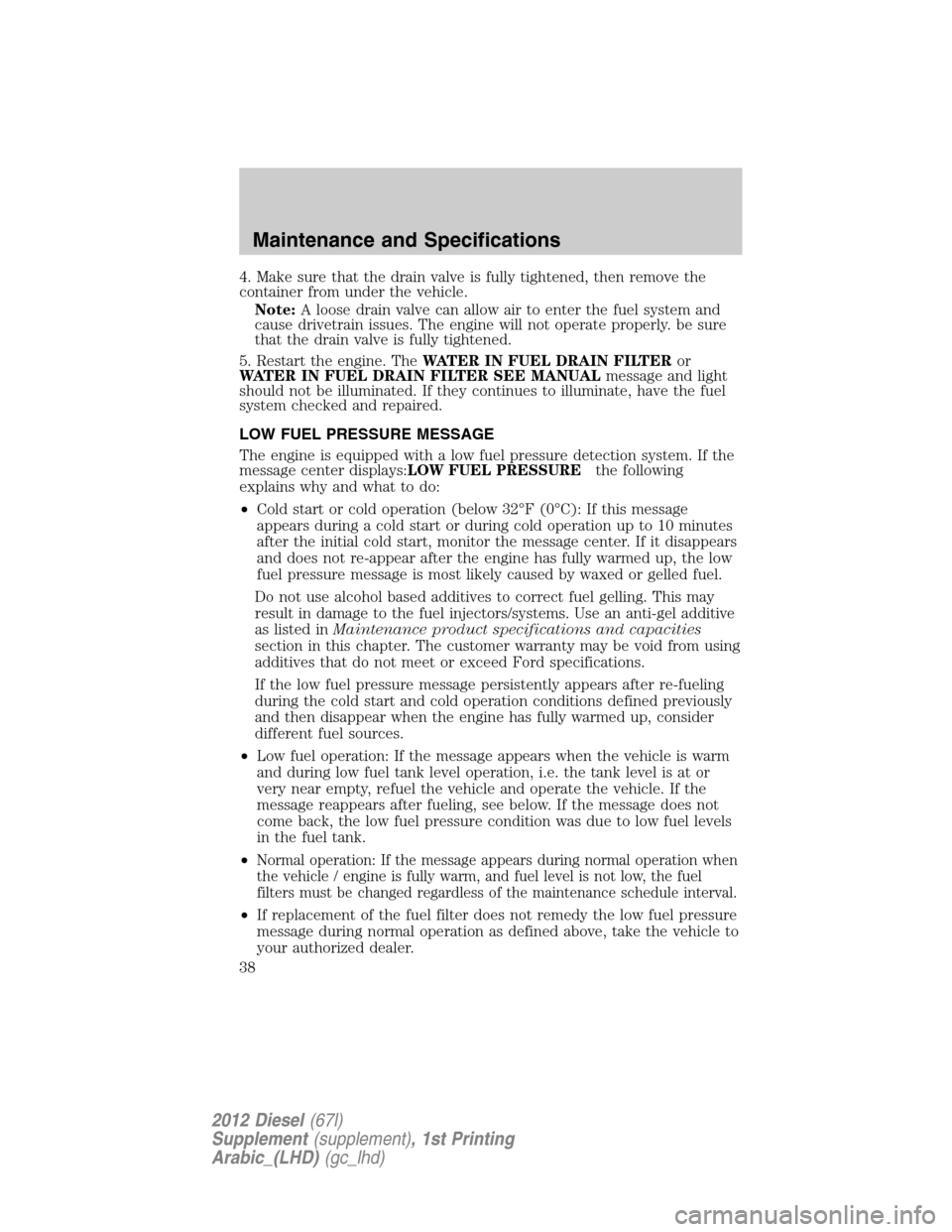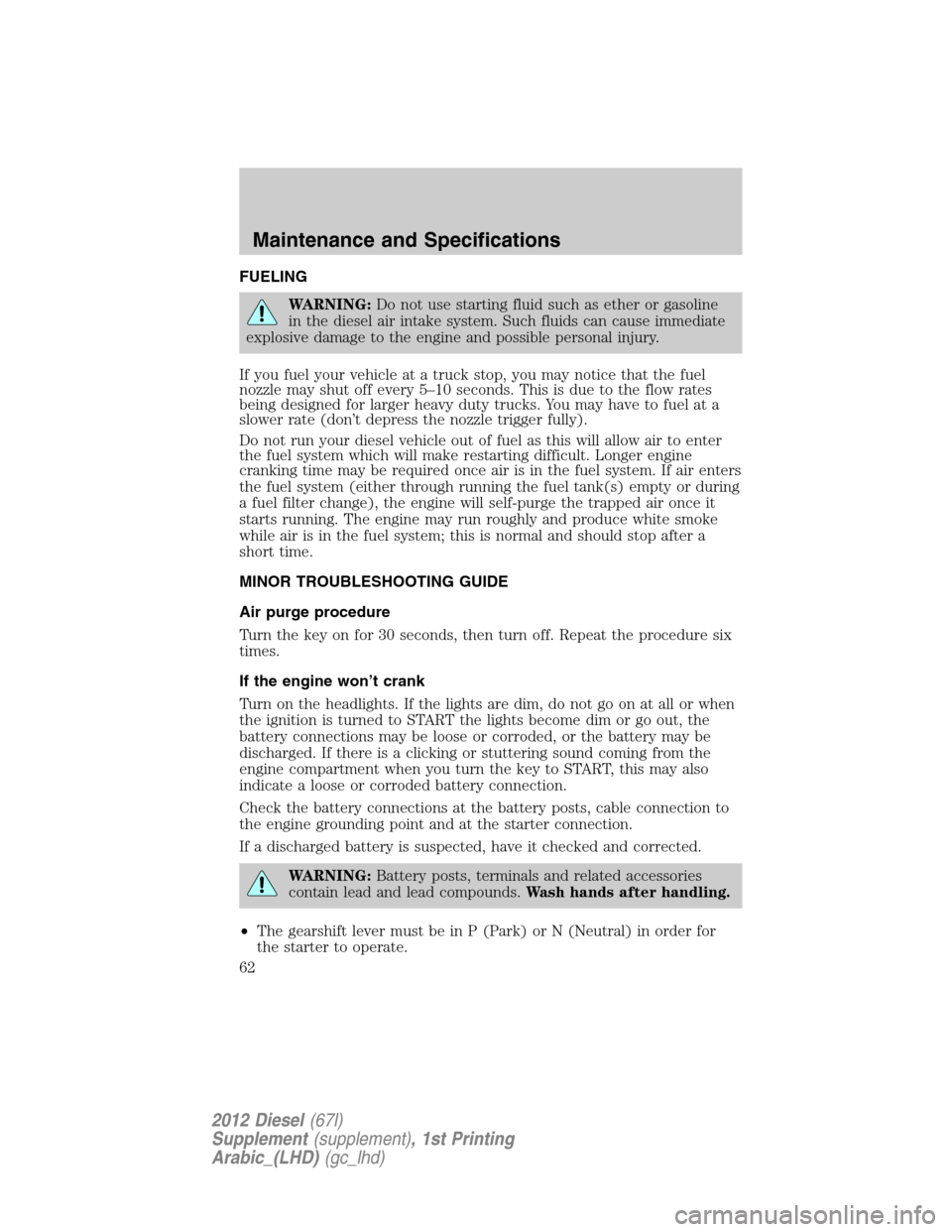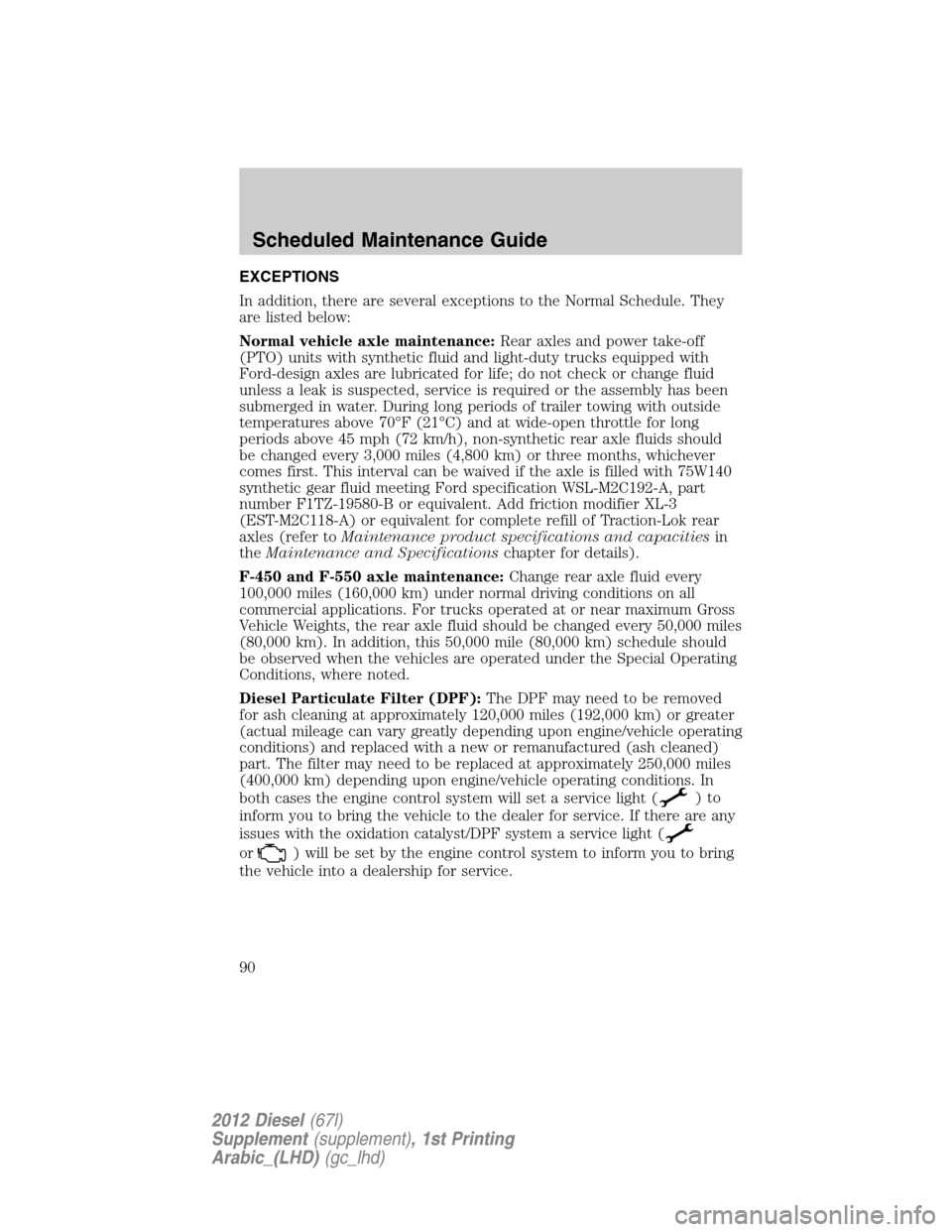2012 FORD SUPER DUTY check engine light
[x] Cancel search: check engine lightPage 38 of 93

4. Make sure that the drain valve is fully tightened, then remove the
container from under the vehicle.
Note:A loose drain valve can allow air to enter the fuel system and
cause drivetrain issues. The engine will not operate properly. be sure
that the drain valve is fully tightened.
5. Restart the engine. TheWATER IN FUEL DRAIN FILTERor
WATER IN FUEL DRAIN FILTER SEE MANUALmessage and light
should not be illuminated. If they continues to illuminate, have the fuel
system checked and repaired.
LOW FUEL PRESSURE MESSAGE
The engine is equipped with a low fuel pressure detection system. If the
message center displays:LOW FUEL PRESSUREthe following
explains why and what to do:
•Cold start or cold operation (below 32°F (0°C): If this message
appears during a cold start or during cold operation up to 10 minutes
after the initial cold start, monitor the message center. If it disappears
and does not re-appear after the engine has fully warmed up, the low
fuel pressure message is most likely caused by waxed or gelled fuel.
Do not use alcohol based additives to correct fuel gelling. This may
result in damage to the fuel injectors/systems. Use an anti-gel additive
as listed inMaintenance product specifications and capacities
section in this chapter. The customer warranty may be void from using
additives that do not meet or exceed Ford specifications.
If the low fuel pressure message persistently appears after re-fueling
during the cold start and cold operation conditions defined previously
and then disappear when the engine has fully warmed up, consider
different fuel sources.
•Low fuel operation: If the message appears when the vehicle is warm
and during low fuel tank level operation, i.e. the tank level is at or
very near empty, refuel the vehicle and operate the vehicle. If the
message reappears after fueling, see below. If the message does not
come back, the low fuel pressure condition was due to low fuel levels
in the fuel tank.
•
Normal operation: If the message appears during normal operation when
the vehicle / engine is fully warm, and fuel level is not low, the fuel
filters must be changed regardless of the maintenance schedule interval.
•If replacement of the fuel filter does not remedy the low fuel pressure
message during normal operation as defined above, take the vehicle to
your authorized dealer.
Maintenance and Specifications
38
2012 Diesel(67l)
Supplement(supplement), 1st Printing
Arabic_(LHD)(gc_lhd)
Page 62 of 93

FUELING
WARNING:Do not use starting fluid such as ether or gasoline
in the diesel air intake system. Such fluids can cause immediate
explosive damage to the engine and possible personal injury.
If you fuel your vehicle at a truck stop, you may notice that the fuel
nozzle may shut off every 5–10 seconds. This is due to the flow rates
being designed for larger heavy duty trucks. You may have to fuel at a
slower rate (don’t depress the nozzle trigger fully).
Do not run your diesel vehicle out of fuel as this will allow air to enter
the fuel system which will make restarting difficult. Longer engine
cranking time may be required once air is in the fuel system. If air enters
the fuel system (either through running the fuel tank(s) empty or during
a fuel filter change), the engine will self-purge the trapped air once it
starts running. The engine may run roughly and produce white smoke
while air is in the fuel system; this is normal and should stop after a
short time.
MINOR TROUBLESHOOTING GUIDE
Air purge procedure
Turn the key on for 30 seconds, then turn off. Repeat the procedure six
times.
If the engine won’t crank
Turn on the headlights. If the lights are dim, do not go on at all or when
the ignition is turned to START the lights become dim or go out, the
battery connections may be loose or corroded, or the battery may be
discharged. If there is a clicking or stuttering sound coming from the
engine compartment when you turn the key to START, this may also
indicate a loose or corroded battery connection.
Check the battery connections at the battery posts, cable connection to
the engine grounding point and at the starter connection.
If a discharged battery is suspected, have it checked and corrected.
WARNING:Battery posts, terminals and related accessories
contain lead and lead compounds.Wash hands after handling.
•The gearshift lever must be in P (Park) or N (Neutral) in order for
the starter to operate.
Maintenance and Specifications
62
2012 Diesel(67l)
Supplement(supplement), 1st Printing
Arabic_(LHD)(gc_lhd)
Page 90 of 93

EXCEPTIONS
In addition, there are several exceptions to the Normal Schedule. They
are listed below:
Normal vehicle axle maintenance:Rear axles and power take-off
(PTO) units with synthetic fluid and light-duty trucks equipped with
Ford-design axles are lubricated for life; do not check or change fluid
unless a leak is suspected, service is required or the assembly has been
submerged in water. During long periods of trailer towing with outside
temperatures above 70°F (21°C) and at wide-open throttle for long
periods above 45 mph (72 km/h), non-synthetic rear axle fluids should
be changed every 3,000 miles (4,800 km) or three months, whichever
comes first. This interval can be waived if the axle is filled with 75W140
synthetic gear fluid meeting Ford specification WSL-M2C192-A, part
number F1TZ-19580-B or equivalent. Add friction modifier XL-3
(EST-M2C118-A) or equivalent for complete refill of Traction-Lok rear
axles (refer toMaintenance product specifications and capacitiesin
theMaintenance and Specificationschapter for details).
F-450 and F-550 axle maintenance:Change rear axle fluid every
100,000 miles (160,000 km) under normal driving conditions on all
commercial applications. For trucks operated at or near maximum Gross
Vehicle Weights, the rear axle fluid should be changed every 50,000 miles
(80,000 km). In addition, this 50,000 mile (80,000 km) schedule should
be observed when the vehicles are operated under the Special Operating
Conditions, where noted.
Diesel Particulate Filter (DPF):The DPF may need to be removed
for ash cleaning at approximately 120,000 miles (192,000 km) or greater
(actual mileage can vary greatly depending upon engine/vehicle operating
conditions) and replaced with a new or remanufactured (ash cleaned)
part. The filter may need to be replaced at approximately 250,000 miles
(400,000 km) depending upon engine/vehicle operating conditions. In
both cases the engine control system will set a service light (
)to
inform you to bring the vehicle to the dealer for service. If there are any
issues with the oxidation catalyst/DPF system a service light (
or) will be set by the engine control system to inform you to bring
the vehicle into a dealership for service.
Scheduled Maintenance Guide
90
2012 Diesel(67l)
Supplement(supplement), 1st Printing
Arabic_(LHD)(gc_lhd)